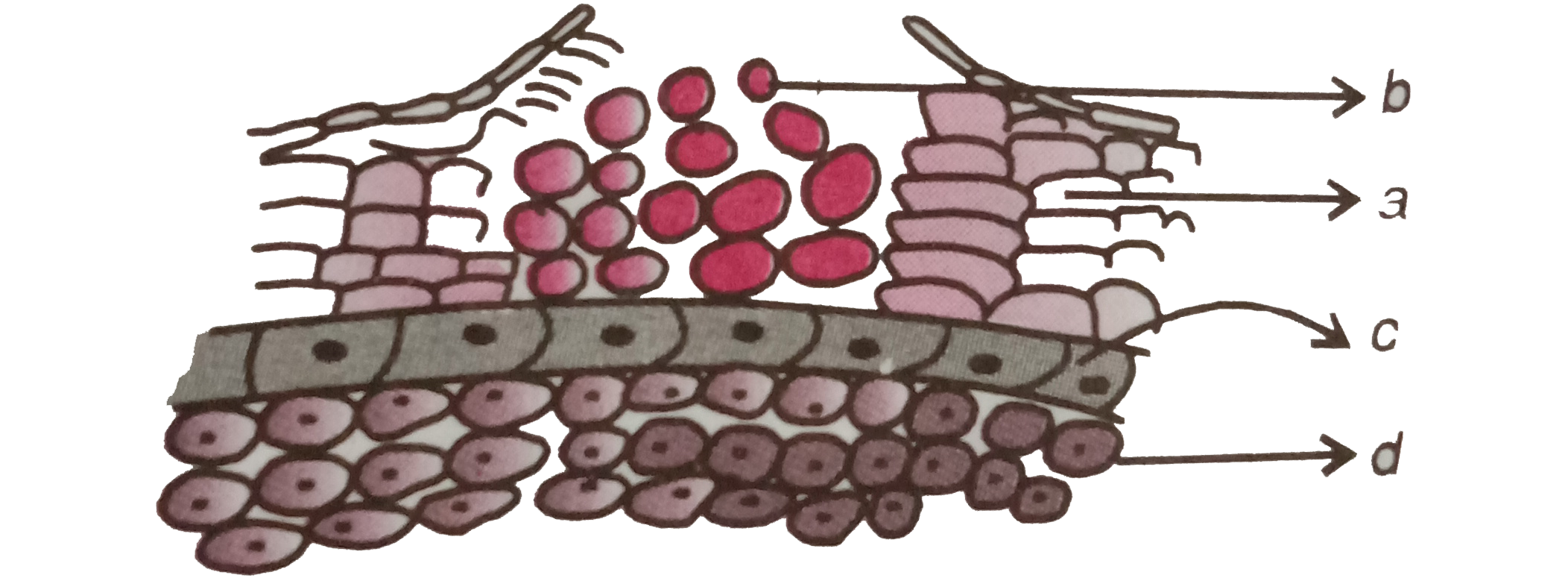A: Complementary cells are cut-off by phellogen towards outside.
R: Phellogen is partially secondary in origin.
If both Assertion & Reason are true and the reason is the correct expalanation of the assertion. Then mark (1).
If Assertion & Reason are true but the reason is not the correct explanation of the assertion, then mark (2)
If Assertion is true statement but Reason is false, then mark (3).
If both Assertion and Reason are false statements, then mark (4)
The correct Answer is:C
Step-by-Step Solution:
1. Understanding the Assertion (A): The assertion states that "complementary cells are cut-off by phellogen towards outside."
- Explanation: Phellogen, also known as cork cambium, is a type of secondary meristem that contributes to the formation of the outer protective layer of the plant. It divides to produce cork cells on the outside and phelloderm (a type of parenchyma) on the inside. The complementary cells mentioned are associated with lenticels, which are formed when phellogen cuts off parenchymatous cells that allow gas exchange.
2. Understanding the Reason (R): The reason states that "phellogen is partially secondary in origin."
- Explanation: Phellogen is indeed a secondary meristem, meaning it arises from the differentiation of existing tissues rather than from primary meristems (which are responsible for primary growth). However, the statement claims it is "partially" secondary, which is misleading.
3. Evaluating the Truth of the Statements:
- The assertion (A) is true because complementary cells are indeed formed as a result of the action of phellogen during secondary growth.
- The reason (R) is false because phellogen is entirely secondary in origin, not partially.
4. Conclusion: Based on the evaluation, the assertion is true while the reason is false. Therefore, the correct answer to the question is that the assertion is true and the reason is false.
Final Answer:
- Assertion (A): True
- Reason (R): False
- Explanation: Phellogen, also known as cork cambium, is a type of secondary meristem that contributes to the formation of the outer protective layer of the plant. It divides to produce cork cells on the outside and phelloderm (a type of parenchyma) on the inside. The complementary cells mentioned are associated with lenticels, which are formed when phellogen cuts off parenchymatous cells that allow gas exchange.
- Explanation: Phellogen is indeed a secondary meristem, meaning it arises from the differentiation of existing tissues rather than from primary meristems (which are responsible for primary growth). However, the statement claims it is "partially" secondary, which is misleading.
- The assertion (A) is true because complementary cells are indeed formed as a result of the action of phellogen during secondary growth.
- The reason (R) is false because phellogen is entirely secondary in origin, not partially.
- Assertion (A): True
- Reason (R): False
Topper's Solved these Questions
Similar Questions
Identify the statements as true (T) or false (F) w.r.t secondary growth in root and choose the correct option.
I. Vascular cambium is partially secondary in origin.
II. Vascular cambium is formed as continuous and complete but wavy ring.
III. Cork cambium arises from cortical cells.
View SolutionThe loose tissue formed by the lenticel phellogen towards the outside is called ………….
View Solutionthe cells forming phellogen are.
View SolutionConsider the following statement:
(a) Complimentary cells are thin walled, rounded, colourless parenchymatous and non-suberized
(b) secondary phloem and periderm are included in bark.
(c) In a dicot root, vascular combium is completely secondary in origin
(d) In a dicot root, vascular cambium is initially wavy which later becomes circular. How many of above statemetns are correct?
View SolutionWhich of the following tissue makes phellogen during the secondary growth in dicot roots?
View SolutionVascular cambium cuts off cells more
View SolutionStudy the given statements carefully and give the answer.
(A)Bark is a nontechnical term that refers to all tissues exterior to the vascular cambium only
(B)Phellem, phellogen and phelloderm are collectively called pericarp.
(C)In the dicot stem vascular cambium is completely secondary in origin.
(D)In dicot stem endodermis cells are rich in starch grains and the layer is also called starch sheath.
View SolutionIn the diagram of lenticel, identify the parts a, b, c, and d

(1) a - complementary cells, b-phellogen, c- phelloderm , d-periderm
(3) a- complementary cells , b- phellem, c-periderm , d- phelloderm
(3) a-phellem , b-periderm, c-phellogen, d-phelloderm
(4) a-phellem, b-complementary cells, c-phellogen , d-phelloderm
View SolutionA : Retina is arranged anatomically in reverse order from what might be expected.
R : The receptor cells are , towards the outside and ganglionic cells towards the inside and light must pass through the nerve cells to reach them.
View SolutionWhich of the following statement is / are not true
A. Cork cambium is otherwise called phellogen
B. Cork is otherwises called phellem
C. Secondary cortex is otherwise called peirderm
D. Cork cambium, cork and secondary cortex are collectively called phelloderm
View Solution
